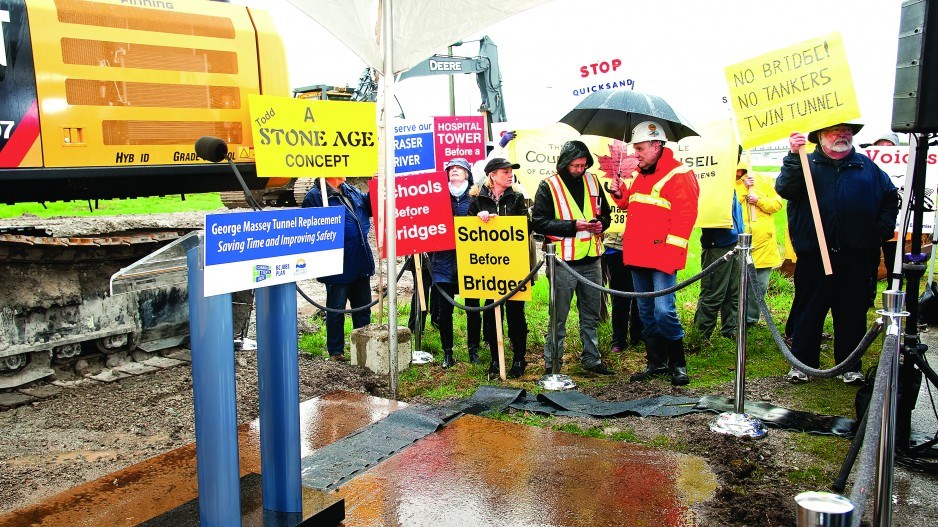The BC Liberal government unofficially kicked off its election campaign last week with a groundbreaking ceremony on its flagship capital works project: a $3.5 billion bridge that will replace the George Massey Tunnel.
The new 10-lane toll bridge over the Fraser River’s south arm will take five years to build and employ 9,000 workers, said Transportation Minister Todd Stone.
Not surprisingly, the April 5 ceremony took place on the Delta side of the river rather than the Richmond side. The City of Richmond opposes the bridge; Delta Mayor Lois Jackson strongly supports it.
So does the Tsawwassen First Nation, which sees the new bridge as an important part of its economic development plans, including the new Tsawwassen Mills mall and various port-
related logistics businesses.
The Greater Vancouver Board of Trade (GVBOT) and other business groups also support the project.
“In terms of goods movement infrastructure, it is No. 1 on our list,” said GVBOT CEO Iain Black.
But, with the exception of Jackson, Metro Vancouver mayors are opposed to the Massey tunnel replacement project. They want provincial spending invested on other projects, including Surrey light-rail transit (LRT) and the Broadway Millennium Line extension.
“The Massey bridge project seemed to jump the queue and come out of nowhere, whereas the projects listed in the mayors’ plan are something that has been talked about and planned about for many years,” Jonathan Cote, mayor of New Westminster, said on behalf of TransLink’s Mayors’ Council on Regional Transportation.
The mayors, however, have been unable to agree to – or get taxpayers to agree to – a funding formula to cover their 20% share of the projects’ capital costs.
Stone said building the Massey bridge doesn’t preclude the provincial government from spending on other transit projects. Two weeks ago, the province announced it would match the federal government’s commitment of $2.2 billion for transit infrastructure.
Black said the mayors need to consider expanded tolls, property tax increases and other funding sources to cover their share of big-ticket transit infrastructure projects, rather than the development cost charges being proposed, which Black said would deepen Vancouver’s housing affordability crisis.
“One of the challenges you’ve got with the mayors is they won’t even start a conversation with property taxes,” Black said.
Whereas most highways and bridges are a provincial responsibility, projects like Surrey LRT are a TransLink responsibility. So while the B.C. government needs the mayors’ co-operation on things like Surrey LRT, it can proceed with projects like the Massey bridge without them.
“I don’t report to the mayors of Metro Vancouver,” Stone said. “I report to the taxpayers of British Columbia. And the taxpayers of British Columbia, particularly the residents who live south of the Fraser, overwhelmingly have said they want this bridge.”
Highways 99 and 91 are part of a vital regional transportation link for trade, serving ports and the Tsawwassen ferry terminal and providing the main route for traffic to and from the U.S.
Around 80,000 cars and trucks per day pass through the 58-year-old Massey tunnel, creating one of the Lower Mainland’s worst traffic bottlenecks.
But Richmond Coun. Carol Day said the province could fix the bottleneck by upgrading the Massey tunnel and twinning it.
“We could twin the tunnel with an immersed tunnel and have it done in less than two years for a lot less money.”
Day added that the province is fixated on a bridge because the Port of Vancouver wants the tunnel removed so it can dredge the river to accommodate larger vessels.
But Stone said the river could not accommodate larger vessels because there would be no way for them to turn around.
“There is no dredging as part of this project,” he said. “This bridge does not in any way facilitate larger ships from getting up and down the Fraser. This is not about addressing any specific needs that the port has.”




